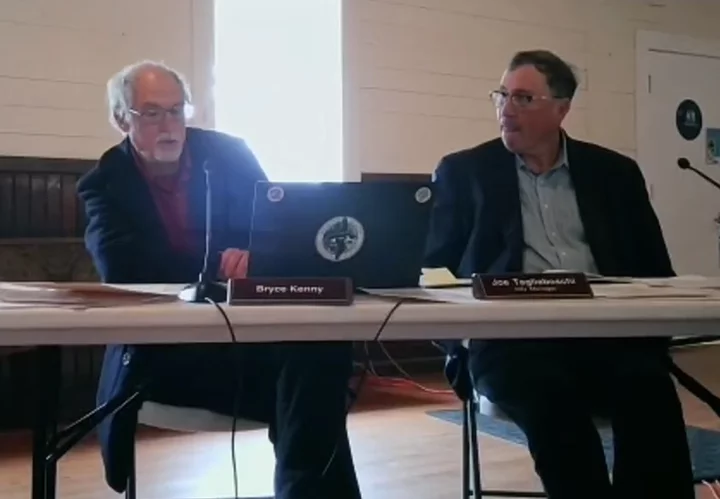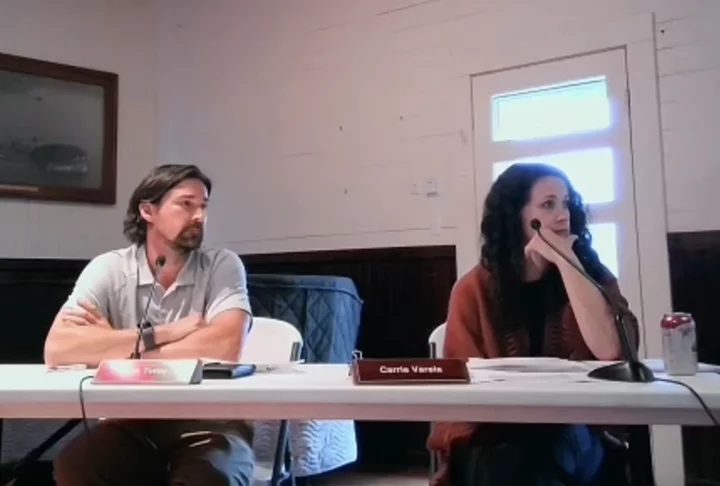OBITUARY: Edris ‘Lavada’ Glavich, 1932-2025
LoCO Staff / Friday, July 11 @ 6:56 a.m. / Obits
Edris ‘Lavada’ Glavich was welcomed into God’s loving arms with family singing her favorite hymns at her side on March 10, 2025, in Eureka. She was 92 years old. Lavada was born on July 18, 1932, in Olustee, Oklahoma. She was the daughter of Otto and Emma (Weems) Watts, both from Oklahoma. She loved her lord and was a founding member of the Eureka Church of Christ.
Lavada’s parents, like so many others from Oklahoma, migrated to California when Lavada was three years old due to the Dust Bowl and the Great Depression, where they sought better opportunities in California’s agriculture. They worked hard to provide for their family, and when World War II erupted, they moved to Richmond, to work in the city’s booming shipyards. After the war ended, they relocated once again to Eureka, where they remained, loved, and lived life to its fullest.
Lavada eloped with high school sweetheart Raymond Glavich in October 1950 in Reno, Nevada. Within a year of their marriage, Ray was drafted in the Korean War. Within months after Ray left, she gave birth to their first of five children, Dana. During this time, Lavada lived with her parents and began her first job at Marrion’s Florist (later to become Eureka Florist). Upon Ray’s return in 1953, she left her career as a florist to stay at home and raise her growing family. During this period, she continued to donate her time by creating wedding flowers for family and friends. Lavada returned to work in 1977 at Eureka Florist, where she continued until her retirement in 2003. During her employment, she formed many close friendships and developed a strong bond with her work family. She worked for her close friend, Peggy Lemos VanDoorn, and, as the florist changed hands, she continued to work for Pat Sanders & Jan Westlund, and finally for Mary Lou Goodwin and Kris Chorbi.
Lavada loved being a mother, grandmother, and great-grandmother and caring for her family. She had an infectious laugh, a wonderful smile, awesome dimples, and lived life to the fullest. Lavada did not have a single mean bone in her body! She loved flowers and was known throughout her family and friends for her hand-written notes and cards, as well as her Blackberry Pie, Jam and Sausage Breakfast Rolls.
Since 1990, Lavada truly enjoyed her monthly luncheons with the Eureka High School “Lunch Bunch,” which was started by the class of 1950.
Lavada is survived by her sisters, Kay Bonner and Kathy Scriven, her son Dana and his wife Lynette, son Kerry and his wife Merijean, son Jeffrey and his wife Mary, daughter Holly and her husband Ron, son Andrew and his wife Cindy, along with grandchildren, Nathan Glavich and wife Tamara, Derek Glavich and his wife Rachel, Marcia Brady and her husband Carson, Hallyann Roper and her husband James, Don Glavich and his wife Mary, Linden Glavich and his wife Abbygail, Jason Skipper and his wife Shayna, Josh Skipper and his wife Ginny, Alexa Stefanakis and her partner Alex, Dimitri Stefanakis, Gabrielle Daysog and her husband Drew, Molly Glavich and Carson Glavich.
Lavada was blessed with 22 great-grandchildren. Lavada’s family meant the world to her.
She is also survived by numerous nieces and nephews, as well as many cousins, including the Rosser family, with whom she was very close.
Reunited with loved ones who have gone on before her, parents Otto and Emma Watts, her brothers, Eldon, Dave, and Kenny Watts, and her “special sister” Barbara Glavich.
Lavada’s family is especially grateful to Sherry Reeves and Caren Matlock, who visited Lavada often over the last two months of her life. And special thanks for all the cards that Lavada received in the last stages of her illness. If you knew Lavada, you’ve probably received many cards from her over the years!
A celebration of life for Lavada will be held on July 19 at 11 a.m. at the Church of Christ, 16th and I Streets, in Eureka, with a reception to follow immediately.
###
The obituary above was submitted on behalf of Lavada Glavitch loved ones. The Lost Coast Outpost runs obituaries of Humboldt County residents at no charge. See guidelines here.
BOOKED
Yesterday: 3 felonies, 10 misdemeanors, 0 infractions
JUDGED
Humboldt County Superior Court Calendar: Today
CHP REPORTS
No current incidents
ELSEWHERE
EcoNews: Plankton Sampling | July 18
RHBB: Powerline Fire Near Dean Creek Road North of Redway Cuts Power to Over 800 Customers this Evening
CBS News : FDA approves new blue food dye derived from gardenia fruit
CBS Bay Area: Sonoma sheriff identifies victims in separate weekend drownings
OBITUARY: Frank Arruda, Jr., 1930-2025
LoCO Staff / Friday, July 11 @ 6:56 a.m. / Obits
Frank Arruda, Jr.
December 30, 1930 – July 4, 2025
Frank Arruda, Jr., “Sarge” a proud United States Marine, Corps veteran and beloved husband, stepfather, grandfather, great-grandfather (and known to family as “the Godfather”) passed away peacefully at home in Eureka on July 4, 2025, at the age of 94, of natural causes. He was surrounded by his loving family.
Born in Rhode Island on December 30, 1930, Frank was the oldest of nine children. In 1946, his family relocated to California in search of new opportunities. In 1952, Frank enlisted into the U.S. Marine Corps, where he began a distinguished 21-year military career that took him across the country and around the world. Frank rose to the rank of Master Sergeant and served honorably in Korea, Vietnam, and stationed in multiple bases throughout the World, specializing in aircraft mechanics and metalwork. During his tour in Vietnam from 1967 to 1968, he managed the Metal Shop at Marble Mountain Marine Corps Air Facility, often working under direct enemy fire to keep helicopters in the air. After his father’s passing, he returned to the U.S. and completed his military service in Jacksonville, North Carolina, retiring in 1973. Upon his return to Eureka, Frank began a second career at Redwood Kenworth, where he worked in inventory and parts management, retiring after two decades.
Frank was deeply committed to helping others whenever he could. This dedication led him to become involved with several fraternal and community organizations, including the Moose Lodge, the Portuguese Society, the Masonic Lodge, and the Order of the Eastern Star. He served as a Past President of the Portuguese Society and was a long-time flag bearer for the Arcata Eastern Star Chapter. In 2016, Frank was honored by Six Rivers Masonic Lodge, #106, with one of Masonry’s highest awards—the Hiram Award—for his service and dedication. He shared many joyful moments with his brothers and sisters from these organizations. For those of us who knew Frank, his positive outlook and generous spirit will continue to inspire us.
In 1988, he married the love of his life, Jean White, and the two shared 37 joyful years together filled with travel, and family. They especially enjoyed vacations to Maui, cruises to Alaska, the Caribbean and Mexico, and any time spent with their large extended family. There would always be laughter, singing and guitar playing anytime the siblings got together. Frank is survived by his wife, Jean Arruda, and three stepsons: Jeff White and Lisa McCombs, David and Lisa White, and Jim and Lori White. He leaves behind a legacy of love through his grandchildren and great-grandchildren:
- Matthew White, with great-granddaughters Lily and Quinn
- John Brown and Morgan Brown
- Vincent and Jenn Gulick, with great-grandchildren Maddie, Zach, and Jacob
- Daniel and Tiffany Gulick, with great-grandchildren Makenzie, Grant, and Carter
- Keith and Paige White, with great-grandchildren James and Emma
- John and Tawnya White, with great-grandson Trent
- Krisha and Cameryn White, with great-granddaughter Briella
Frank is also survived by his sister Emmie Arruda Peterson and her husband John, his brother Leonard Arruda and wife Debbie, and his sisters-in-law Judy Arruda and Pat Arruda. And his best friend Angelo and Roberta Marcelli along with many nieces and nephews who adored him.
A special thank you to Franks caregivers: Holly, Rosie, and Hospice of Humboldt. Masonic services will be Monday, July 14, 10 a.m. at Goble’s Funeral Home (560 12th St., Fortuna), followed by graveside Military Honors at Sunset Memorial Park (3975 Broadway St., Eureka).
Pall Bearers: Vincent Gulick, Daniel Gulick, Keith White, Matthew White, John White and Krisha White.
###
The obituary above was submitted on behalf of Frank Arruda’s loved ones. The Lost Coast Outpost runs obituaries of Humboldt County residents at no charge. See guidelines here.
College of the Redwoods Announces Rodeo Partnership with the Humboldt County Fairgrounds
LoCO Staff / Thursday, July 10 @ 4:44 p.m. / LoCO Sports!
College of the Redwoods (CR) announced today that they’d reached a deal with the Humboldt County Fairgrounds to use their facilities for their new rodeo program, which was announced last year but hasn’t started competing yet. According to Molly Blakemore, director of marketing and communications at CR, the fairgrounds aren’t charging CR for use of their facilities, but CR will be paying for upgrades to their lighting systems and cattle chutes out of a $100,000 fund CR set aside for the program.
Press release from CR:
College of the Redwoods (CR) is kicking off its inaugural rodeo season this fall with a major partnership that gives the new team a home base for training and growth. CR and the Humboldt County Fair Association (HCFA) have signed a Memorandum of Understanding (MOU), allowing R Rodeo to practice, train, and house their animals at the historic Ferndale Fairgrounds starting August 1, 2025.
“This is a milestone collaboration for our rodeo community,” said Interim Athletic Director Ryan Bisio. “We’re so thankful to the wonderful folks at the Ferndale Fairgrounds for sharing our vision and giving our rodeo athletes a home. Years of dedicated work by many people has created this exciting outcome. I know our coaches and student-athletes can’t wait to get started at the Fairgrounds next month – with their eyes set on our inaugural intercollegiate competitions this fall.”
The agreement allows CR’s growing rodeo team — currently three men and one woman, with more student-athletes actively being recruited — to utilize the arena and related facilities for practices and training from late August through mid-June. The team will also have access to stalls for their horses and the opportunity to host one off-site rodeo event each year.
“We’re thrilled to be partnering with College of the Redwoods to bring collegiate rodeo practices to the Humboldt County Fairgrounds for the first time,” said Moira Kenny, CEO of the Humboldt County Fair Association. “This exciting collaboration celebrates our shared roots in agriculture and western tradition while supporting the next generation of student-athletes. This partnership represents a new chapter in our mission to support youth and community programming, and we’re honored to provide a home for CR’s rodeo athletes to train and grow. It’s exciting to see the fairgrounds continue to evolve as a hub for tradition, education, and western heritage.”
CR has also proposed improvements to the arena facilities as part of the partnership, aimed at enhancing usability and safety for both student-athletes and community members.
With its inaugural season on the horizon, the CR Rodeo Team is positioning itself as an exciting new chapter in the college’s athletics program and a point of pride for Humboldt County’s agricultural and western heritage.
Amid Controversy, Trinidad City Council Narrowly Opts to Pursue a Study on an Alternate Water Supply
Ryan Burns / Thursday, July 10 @ 4:26 p.m. / Local Government , Trinidad
Trinidad Mayor Cheryl Kelly and Councilmember Kati Breckenridge.
###
PREVIOUSLY
###
After sourcing its water from the Luffenholtz Creek watershed for the past 50 years, the City of Trinidad is ready to explore another possibility.
With a 3-2 vote on Tuesday night, the Trinidad City Council directed staff to pursue a study analyzing the pros and cons of switching its supply from Luffenholtz to the Humboldt Bay Municipal Water District (HBMWD), which delivers water from Ruth Lake and the Mad River to more than 88,000 customers in Eureka, Arcata, McKinleyville, Blue Lake, Manila and other local communities.
This prospect, which the city has discussed for more than six years, has long been controversial in this picturesque seaside community, where many residents worry that hooking into a mainline extension from HBMWD would open the floodgates to rapid population growth, potentially ruining the community’s quaint character.
However, the city’s largest water customer, the Trinidad Rancheria, is independently pursuing its own connection to HBMWD, in part so that it can proceed with plans to build a five-story, 100-room Hyatt hotel overlooking Trinidad Harbor. The Rancheria’s departure would increase costs for Trinidad’s remaining ratepayers.
Meanwhile, the city’s water department has other issues, including staffing difficulties, regulatory challenges tied to aging infrastructure and capacity concerns, particularly during drought conditions. During the dry years of 2018-2021, for example, Trinidad implemented emergency conservation measures amid a series of water shortages, which were exacerbated by leaks in the city’s aging infrastructure.
Trinidad Mayor Pro-Tem Bryce Kenny and City Manager Joe Tagliaboschi. | Screenshot.
###
On Tuesday evening, Trinidad City Manager Joe Tagliaboschi said that HBMWD, by contrast, is “known for a high-capacity, reliable source, very good regulatory compliance, and they have economy of scale based on their size that we do not enjoy.”
The Rancheria has invited Trinidad to participate in its own engineering study, and Tagliaboschi said he’s confident that the city could get grant funding to cover the cost, which could be upwards of $200,000.
Public speakers at Tuesday night’s meeting were divided on the topic, with some residents saying the council should pursue a study so that it can make a more informed decision while others voiced strong opposition to pursuing a new water supply.
“More water means more growth, and more growth means a massive change to this unique and beautiful town,” warned one man. (If he identified himself, the microphone didn’t catch it.) “Ten years after that water line comes in, if it does, you won’t recognize this area anymore,” he continued. “You sure as hell won’t recognize Trinidad.”
Other critics expressed concerns about impacts to the environment, saying pipeline construction could cause harm while population growth could lead to increased pollution of groundwater and beaches.
However, another Trinidad water customer said, “Beyond water scarcity, water quality and fire safety issues, it’s now clear that the City of Trinidad can no longer afford to operate its municipal water plant.” She noted that for the past three years, the city has been forced to hire expensive state-licensed consultants to operate the plant. “Please move forward with the feasibility study and ultimately connect to Humboldt water district so that Trinidad can be a water-resilient city,” she concluded.
“I’m in favor of a study,” the following public speaker said. “It just asks you to get information. I don’t know why there’s so much opposition to gaining facts.” He said the community should be worried more about shrinking than growing. “You are making generational decisions right now that will impact the viability with this community, the City of Trinidad, going forward. We are shrinking. We are struggling to fill seats on our council, our planning commission. We gotta be responsible, get data and make responsible decisions.”
Trinidad Rancheria Chief Executive Officer Jacque Hostler-Carmesin said the tribe is definitely moving forward with the pipeline, and an alternatives analysis commissioned by the Rancheria will soon be a public document. “So we’re here to partner if you want to partner,” Hostler-Carmesin. “I think [HBMWD] is the one that’s going to want a decision from the city, but the Rancheria is moving forward very rapidly. We intend to move this into construction within the next two years.”
But Steve Madrone, Humboldt County’s Fifth District Supervisor, said the city should focus on improving the resiliency of its existing system, in part by pursuing distributed storage. He said Luffenholtz Creek has never gone fully dry in its recorded history, and he suggested that a mainline extension from HBMWD could be damaged in an earthquake.
While rates might be cheaper through HBMWD, Madrone said, “It will change the face of this community if you end up deciding to hook into this pipeline or support it in any way.”
When the matter came back to the council for deliberation, Mayor Cheryl Kelly said she was leaning toward pursuing the study so that the council could make a more informed decision.
Mayor Pro-Tem Bryce Kenny, on the other hand, delivered a PowerPoint presentation under a header saying the pipeline “is not a good thing for Trinidad.” Like Madrone, Kenny argued that Luffenholtz Creek has plenty of water to meet the city’s current needs, and he advocated for working to preserve “the special character of this area.”
Trinidad Councilmembers Jack Tuttle and Carrie Varela.
###
Councilmembers Jack Tuttle and Carrie Varela both said they were torn over which way to vote.
“There’s a lot of good points on both sides,” Tuttle said. Varela said the water supply issue is connected to other important municipal concerns, including annexation into the HBMWD’s service area and impacts to the city’s sewer system. But she said she leaned toward doing a feasibility study that compares a variety of options, not just the pipeline.
Councilmember Kati Breckenridge also said she was in favor of a feasibility study.
Mayor Kelly wound up making a motion to direct staff to proceed with an analysis comparing the city’s two primary options:
- staying with the existing system or
- connecting to HBMWD’s supply via a pipeline extension, “maybe down the road, in 20 years, I don’t know,” she said.
Members of the public in attendance interjected as Kelly moved toward calling for a vote. She finally asked for a show of hands. The video of the meeting shows Kelly and Breckenridge raising their hands in support, and Kenny could be heard offscreen voting against the measure. It’s unclear whether Tuttle or Varela cast the third and deciding “yes” vote, but the motion passed.
GREETINGS, CRITTERS! Sequoia Park Zoo Welcomes Long-Awaited Black Bear, Spider Monkeys and Goats
LoCO Staff / Thursday, July 10 @ 4:05 p.m. / Cavy Babies
Photos via Sequoia Park Zoo
###
Press release from the Sequoia Park Zoo:
EUREKA, CA – Summer is in full-swing at the best little zoo in the redwoods, and we are excited to celebrate several recent animal additions to the Sequoia Park Zoo family!
As part of a coordinated move by the Association of Zoos & Aquariums (AZA), we welcomed four spider monkeys to the Zoo. The first to arrive, Sprite was born in 1995 at Sequoia Park Zoo to parents Junior and Candy before moving to John Ball Zoo in Michigan and then to Zoo Miami.
“We are thrilled to reunite Sprite with her mother, Candy, and younger half-brother, Jake,” says Amanda Auston, Animal Curator at Sequoia Park Zoo. “The other new spider monkeys - Sam, Mila, and Melina - will make up a separate troop,” she explains. “People might notice that it’s much louder on this side of the Zoo now! They all like to call to each other.”Behind the scenes in the Barnyard, a baby La Mancha goat and a baby Alpine goat from local cheese company Cypress Grove are currently undergoing a typical quarantine period before they join Grover and the rest of the herd. Animal care staff look forward to sharing their names soon!
Rounding out our new summer arrivals is a much-anticipated American black bear yearling cub placed at the Zoo by California Department of Fish and Wildlife (CDFW) after a remarkable rehabilitation journey with Gold Country Wildlife Rescue. Despite recovering from multiple critical conditions, there remained concerns about his ability to maintain the thick fur necessary for survival in the wild, and CDFW made the decision to transfer him to permanent care at Sequoia Park Zoo.
Every year, state and federal agencies must find placement for a small population of orphaned, injured, or habituated animals, and organizations like the Sequoia Park Zoo play an important role in providing homes and care for these animal ambassadors while educating the public about responsibly living with wildlife.“This little guy comes to us with a huge fanbase that has been cheering him on,” reports Jim Campbell-Spickler, Zoo Director. “We are thankful to California Department of Fish and Wildlife for placing him with us, and we look forward to caring for him and sharing this new chapter of his story.”
The Bear and Coyote habitat at Sequoia Park Zoo was generously funded by the Bear River Band of the Rohnerville Rancheria, whose Council members choose the name for each new bear. Formerly known as “Cub 24-3926” during his rehabilitation, the Council has selected the new name “Kunabulilh” for him, which literally translates to “he bites” in Soulatluk. To learn more about the language of the Wiyot people, including vocabulary, definitions, and pronunciation, please visit https://www.wiyot.us/275/Wiyot-Pronunciation-Vocabulary.
All new animals at the Zoo, regardless of species or history, undergo an industry-standard quarantine before being introduced to other animals and habitat spaces. During this time, observant and patient guests may be able to catch a glimpse of our new arrivals as they begin to settle in, and we ask our visitors to help make them feel safe and comfortable by remaining quiet and calm, especially around the bear habitat.
ICE Agents are Raiding California’s Largest Cannabis Grow Operation Down in Ventura and Santa Barbara Counties Today
Hank Sims / Thursday, July 10 @ 3:24 p.m. / Cannabis
Glass House Brands logo.
Glass House Farms — California’s largest cannabis cultivator, with a reported production capacity of 600,000 pounds per year — is the target of immigration raids in Southern California today.
According to reporting on the ground, the company’s facilities in Camarillo (Ventura County) and Carpinteria (Santa Barbara County) are the scenes of large-scale ICE raids. Protesters have gathered at both locations, with reports of federal agents using tear gas or pepper spray to push the crowds back.
The Santa Barbara Independent, reporting from Carpinteria, says that Rep. Salud Carbajal, along with two councilmembers, were held back by agents as they tried to gain access to the facility while the raid was underway.
Coincidentally, Glass House just cleaned up at the California State Fair’s “Golden Bear” awards for cannabis quality, winning 15 gold, silver or bronze awards in the “mixed light” category.
In Three Weeks, One Humboldt Native Will Attempt to Ride Horses Over 600 Miles Across Mongolia
Dezmond Remington / Thursday, July 10 @ 1:49 p.m. / LoCO Sports!
Photos courtesy of Jenn Laidlaw.
The first thing on Jenn Laidlaw’s mind while she’s helping a horse give birth is the time of day, because going to bed after 3:30 in the morning sucks. In fact, it feels worse than just staying up, so she doesn’t bother going back to bed at all. The horse emerges, preferably led by a head and two legs, and its life and Laidlaw’s day both start at around the same time. Two hours later, the foal can stand, and Laidlaw’s probably back to tending to any of the other dozens of mares she cares for.
Next month, Laidlaw is tackling the Mongol Derby, the longest horse race in the world. Racers cover over 600 miles of Mongolia in 10 days or less, swapping out stocky Mongolian horses provided by families along the way every 20 miles or so, from 7 a.m. to 7 p.m. every day. It’s a grueling reenactment of Genghis Khan’s own, centuries-old version of the Pony Express, a mail system that could supposedly get a letter from the Mongol capital to modern-day Poland in less than 12 days. Now, riders pay upwards of $20,000 to complete the route, and sometimes as many as half of them quit before the race is over.
Laidlaw is, by her own admission, not much of a rider. She mainly works on the managerial side of operations at the horse farm in central Kentucky she runs. She breeds studs, some of them very successful; Code of Honor, a horse she helped raise, took second at the Kentucky Derby in 2019, and plenty sell for more than a house’s down payment.
A Fieldbrook native, Laidlaw, 39, just never kicked the common childhood fascination with horses, and that’s the furthest she can explain the obsession. She raised pigs and sheep for the Future Farmers of America and 4H (“My dad called them ‘expensive lawn ornaments,’ which they actually are”) and showed them at the county fair in Ferndale. During predawn staging sessions, she could sneak away for a minute and groom the racehorses. It made her mom mad, but Laidlaw thought it worthwhile. Watching the horses race stoked the interest, and when she graduated from McKinleyville High School in 2004, she decided she’d study equine science at the University of Kentucky. In horse racing, that’s where the money is.
She’s pretty sure she’s the first person from Humboldt to race the Mongol Derby. Growing up in one-road Fieldbrook, she didn’t know how large the world was.
“I just want people to know you can do anything you want to do,” Laidlaw said in an interview with the Outpost. “And, yeah, I’m sure that there’s crazy little horse girls still up in Humboldt, so maybe they can see this and then want to go do something similar.”
She now oversees a farm with 50-something mares. She once had a horse of her own, but sold it a few years back.
“I do not have the stomach for that much invested in something that can die,” Laidlaw said. “I’m just not into it, you know? I’d rather spend the money on going to Mongolia, I guess.”
The race is a true epic — it’s easy to imagine a Hollywood studio in the ‘50s pouring tens of millions into a film about plucky vagabonds battling the elements and navigating strange, new foreign societies while racing flat-out into the hinterlands. It would be shot in Technicolor and have a runtime of three and a half hours, overture and intermission not included.
Riders cannot weigh more than 187 pounds dressed to ride to avoid hurting the horses, and that includes the mandatory helmet, boots, and snazzy form-fitting jodhpurs. The rest of their luggage has to clock in at less than 11 pounds, and that includes everything besides water. The Mongolian horses provided stand between 12-14 hands high, and though many of them were bred to be racehorses, some of the stock are workers who do whatever task is asked of them.
“Anyone who mistakenly calls them ‘ponies’ will rescind the judgement after riding these diminutive powerhouses,” the race website reads. “These are the same hardy beasts that carried the Mongol warriors over half the world…Accustomed to heat, cold, hunger, thirst, flies, floods, deserts and really anything else that Mongolian mother nature can throw at them, they can cross terrain that would make a thoroughbred weep and maintain speeds that would put them in contention in many a tough endurance ride.”
It’ll be the first time Laidlaw has traveled to Mongolia, though she’s thought about competing in the Derby since 2012. Her roommate at the time completed it, and her blog and social media posts during the race impressed Laidlaw. Blog posts and photos from the race’s media people affected her as well; Laidlaw said their live streams, interviews, and the beautiful shots of riders adventuring in the Mongolian countryside was incredible enough to make her want to go for it.
But mainly Laidlaw needs an adventure, a getaway from a job with actual life-or-death responsibilities (“People say they have bad days at work all the time. I’m, like, ‘Did something die?’ And if the answer is no, I’m, like, ‘Did you really have a bad day at work then?’”) and a recent past marked by the death of her dog and her grandmother.
“I keep joking that my life this year is like a country song,” Laidlaw said. “My wife hasn’t left me yet because” — she laughed — “I don’t have one. I can kind of joke about it now, but it’s been hard.”
Going to Mongolia and riding horses unlike any she’s ever raised from one nomad family to the next for 10 days just kind of happens to be the way she’s decided to have the adventure. She applied to compete in 2023, and in a brilliant stroke of fate, learned she was in the same day she received a job offer.
“There was a lot of ‘Yes’ that day,” Laidlaw said. “…It was a good day. And, you know, ‘Hello! You need to choose one or the other.’ I’m like, ‘Nah, we’ll just do ‘em both. I’ve got two years to get ready. I’ll be fine. It’ll be fine. And those two years have gone by really fast. Really fast!”
Laidlaw hasn’t prepared the way she would have liked to. She’s never done an ultra-endurance ride before; most of her horse riding experience comes down to the occasional lesson and infrequent jaunt back when she owned her horse. She’s done a little bit of training on the farm with a “semi-feral” horse that flipped on top of her, dragged her across a wall, and stepped on her the last time she rode him, supplemented with spin bike classes and doses of manual labor. Still, she’s not that concerned about the probability of failure.
“From what I’ve been told, you can never really be prepared,” Laidlaw said. “Being fit mentally is probably the hardest part, from what I’ve heard, and I’m pretty sure I’ll be OK. [I’ve] been through enough. I’ve done a lot of crazy things. My job really revolves around these kind of things. There are so many kinds of situations where I’m like ‘I don’t know if I can. I’m exhausted. I don’t know if I can keep going.’ And somehow, you’re, just, like, ‘I have to keep going. I have to show up again, and we’re just going to keep doing this.’
“And I think that’s part of the reason I’m going,” she continued. “I just kind of want to test myself again — not again, but just in a different way. More of a personal challenge, because I know I can do it. I just want to prove it to myself.”












